Feed Them Well! About Chicken Nutrition
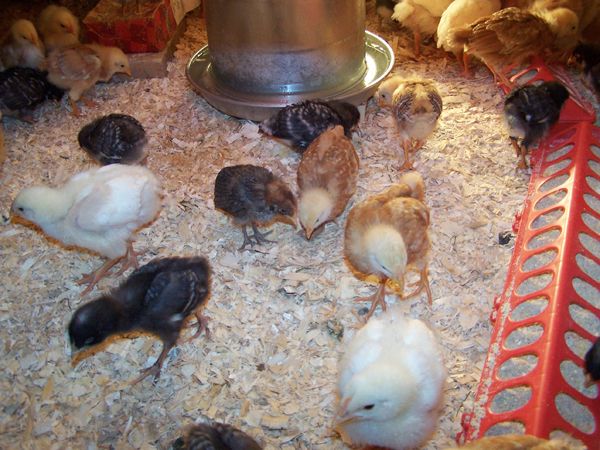
When we got our first flock of broilers, consisting of 50 heritage birds and 25 Cornish Cross, we got a crash course in chicken nutrition. I was on a Yahoo group, Pasture Poultry, that had a Professor of Poultry and a feed mill owner as members.
We had a lot of problems with birds dying, not growing well, and picking. We started out feeding (cheap commercial feed) chick starter, then broiler/grower. They had 24/7 availability to feed, plenty of water, and we’d started supplemental feeding of grit and grass and forbs.
But they kept dying, especially the Cornish. The Professor said to start getting animal protein into them; he didn’t think the feed was high enough protein. We’d tried using a game bird feed with higher protein but that didn’t help. He suggested hamburger, tinned mackerel, anything that was animal protein.
It was about this time I started trying to raise mealworms for protein. But they didn’t multiply fast enough, having something like an 18 week cycle.
So we got meat from cheap or free sources, ground it up and started feeding it out. Initially the rate was ½ oz/bird/day. And suddenly the birds stabilized and the dying stopped.
I then learned a lot about current breeds of chickens and how the industrialization of food had affected them.
The Year of the Chicken
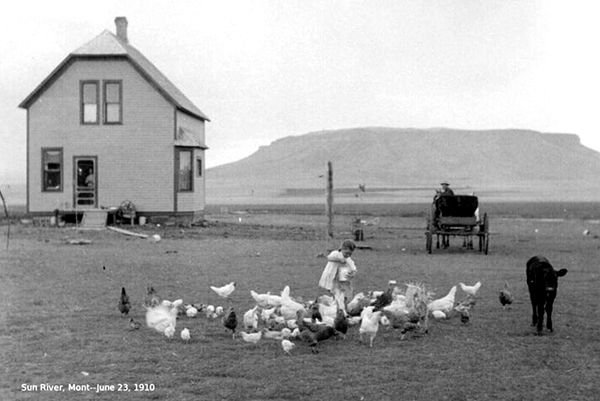
The first thing to know about feeding chickens is that the chicken available today is not the chicken of the 1930’s. The chicken of the 1930’s was smaller framed, had a low ROL (Rate of Lay), and generally was a good forager if allowed to free range.
Chicken of Tomorrow 1948 This movie is 17 mins long. WARNING! Some graphic images
In the late 1940’s there was a program called The Chicken of Tomorrow. It was part of the beginning of the industrialization of animals for food. The idea was to find a breed, or create a breed, that would do well in battery houses, have more meat on them, grow faster, and lay far more eggs.
Most breeds were affected to one degree or another. Some were dropped quickly, as being very unsuitable. Others had deeper breeding changes before being dropped.
http://goldenoakfarm.us/ChickenofTomorrow1951/ChickenofTomorrow1951.pdf
This article in a magazine is on pages 14 – 16. Cover has title also. It is a follow up on the contests.
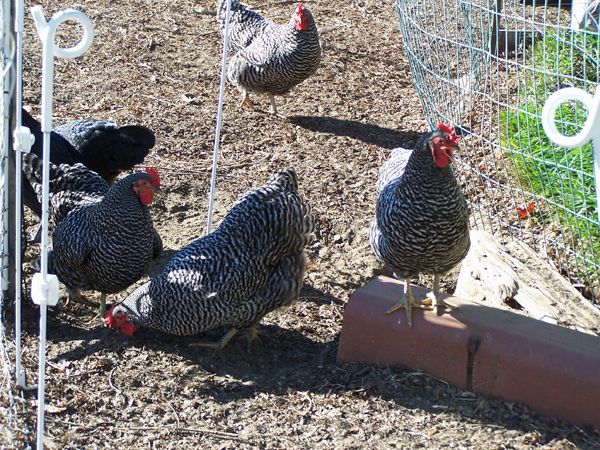
By and large, the chicken of today, even a heritage bird, is heavier in frame and meat, has a ROL of at least 75% or as high as 95%, and may have had such things as foraging skills, predator awareness, and some normal chicken behaviors bred out of them. They were also bred to do well on a concentrated commercial feed that included exact amounts of necessary nutrients.
Your feeding program will depend on what you want from your chickens. If you only have 2-3 and they are mostly pets, then optimal feeding may not be crucial to what you are doing.
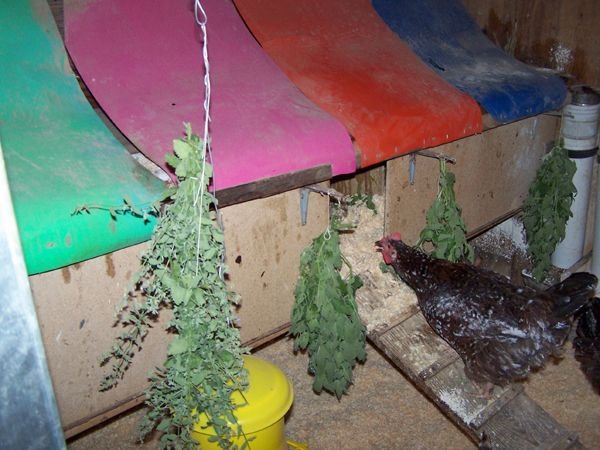
“What did you do to the nestboxes??” - Using herbs for pest repellant and for in the nestboxes
If you have them for eggs, then feeding them properly from the very beginning can insure they will develop the proper laying body frame, lay well, and the eggs you eat, or plan to sell, will be nutrient rich.
If you are doing broilers, proper feeding practices and amounts can be critical to proper frame development and weight gain.
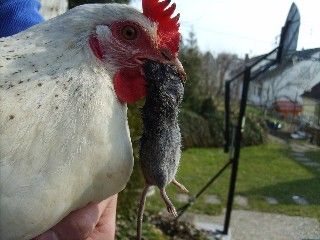
The second thing to know is that chickens are omnivores, meaning they can and do eat nearly anything, and do require animal protein for optimal health.
Up until the 1990’s all poultry feed had animal protein in it. This is because chickens cannot synthesize certain amino acids from plant protein. They need animal protein for complete nutrition.
In the 1990’s when Mad Cow appeared, it was mandated that feed mill owners who wanted to continue putting animal protein in feed had to have a separate facility to do so. That pretty much stopped the inclusion of animal protein in poultry feeds. They just upped the protein in feed and called it good.
A lot of the behavioral problems seen in small coops or confinement houses stem from this lack of animal protein in feed. Feathers are around 90% protein so picking problems are common.
Basic Requirements
A normally-maturing chick (i.e., breeds which mature in about 6 months, such as egg-layers) will eat about 2 pounds of starter feed in its first 6 weeks of life.
A Cornish Cross, however, which is used for meat, will need about 8 pounds of starter feed in its first 6 weeks of life. (These breeds are bred to grow extremely rapidly, and are harvested at 48 days of age.)
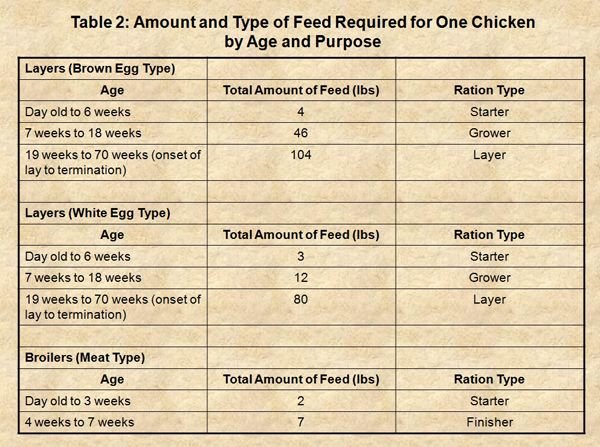
Nutrition for the Backyard Flock.pdf
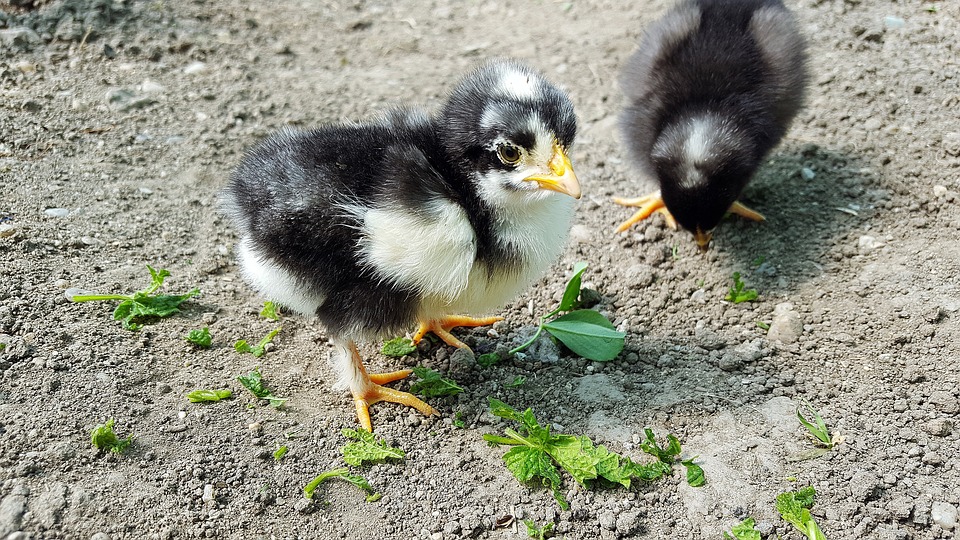
You can start by feeding a good commercial starter feed, and then at about 2 weeks, start supplementing with tiny amounts of animal protein, about 1/16 oz per bird/day. I strongly urge feeding un-medicated organic feed to give them the very best start.
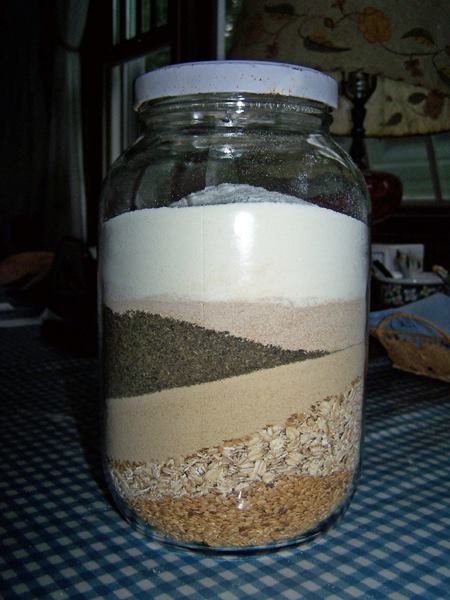
This is a mix of (from the bottom): flax seed, rolled oats, garlic powder, kelp, brewers yeast, and probiotics for feeding to chicks. It’s sprinkled on top of their starter feed.
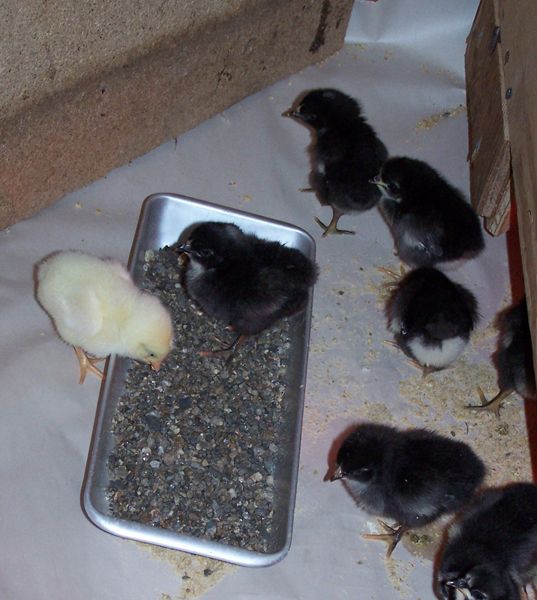
You can also add small amounts of vegetables, fruits, or scratch. Be very careful that they continue to eat all the commercial feed, before the supplementation. In general, the birds of today are bred to do well on commercial feeds. If you do offer these, you need to provide chick sized grit.
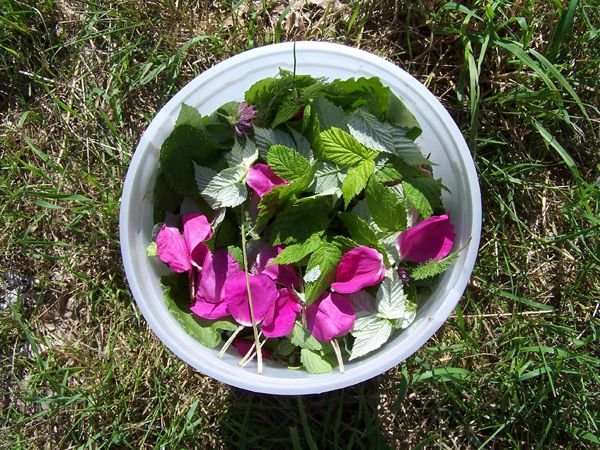
Fresh flowers, leaves, herbs, and forbs for chicks
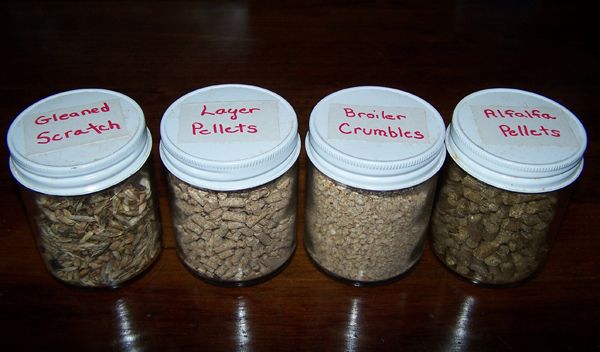
Types of Commercial Feed
Mash: a blend of several feed ingredients, ground to a small size
but not to a powder
Crumbles: pellets broken up into smaller pieces
Pellets: small kernels of compressed mash, causing birds to eat
the whole blend, not pick and choose
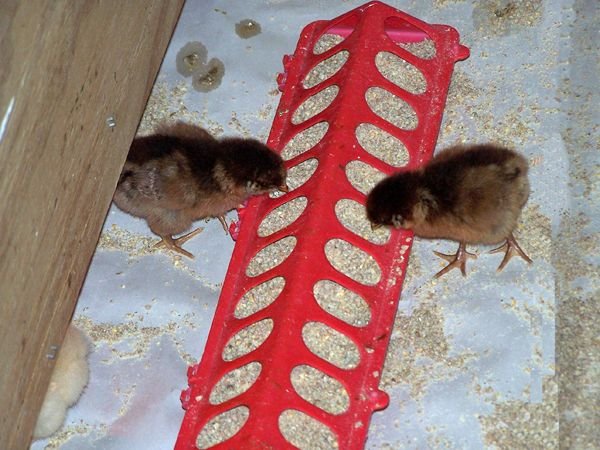
Starter: a blend of feed for chicks and growing birds, usually in the
form of mash; approximately the same as "Grower"; can
be replaced with "adult“ food as soon as chicks go for it,
somewhere between 4 and 8 weeks of age
Grower: approximately the same as "Starter"
Layer: feed blend for chickens that are laying eggs, having extra
calcium and protein added
Broiler: feed blend for chickens that are growing as fast as
possible, in order to be harvested for meat as early as
possible
Scratch: whole grains fed separately to chickens, usually scattered
on the ground or litter of the coop; usually a mixture of
grains, such as wheat, rye, oats, etc. (corn/maize must
be cracked before using as scratch grain)
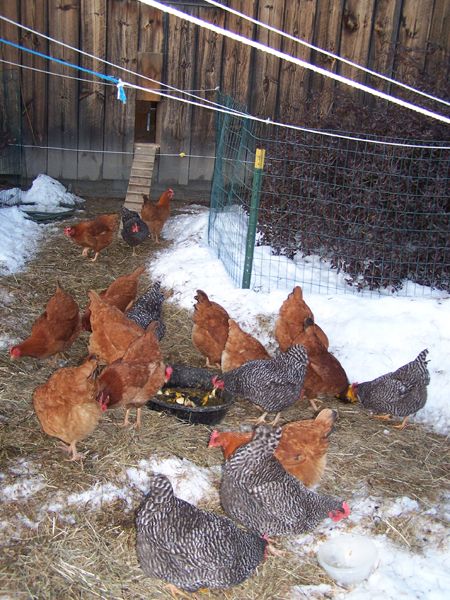
Adult laying chickens consume vastly different amounts of feed. Factors influencing feed consumption include, but are not limited to:
◦ Breed type
◦ How much they exercise
◦ Climate (including:
∞ Variations in temperature
∞ Wind
∞ Humidity
∞ Precipitation
◦ The caloric and nutritional density of the feed
◦ How much natural feed supplementation they obtain
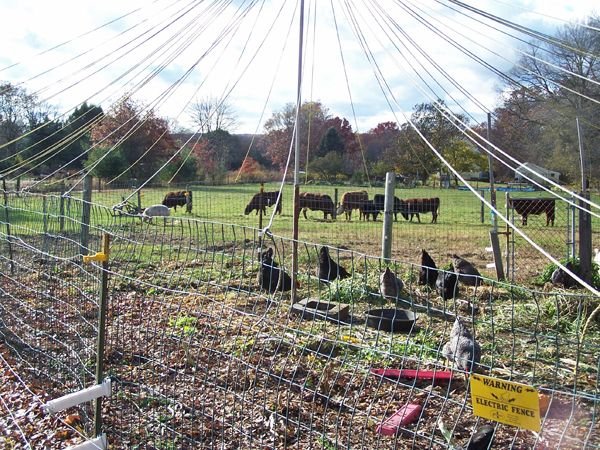
Garden waste for the layers, with their alfalfa mash tray and animal protein trays
Making Your Own Feed:
It is not recommended that backyard owners make their own feed. The chances of being able to incorporate, and have your chickens eat, all the necessary nutrients are not very good. Vitamin mixes sift out of grain mixes, and chickens can take a dislike to one grain or another.
You will need access to a feed mill, either a commercial one that will grind your mix, or a smaller personal mill. You could also have a nutritionist assist in putting together a feed from available grains and supplements.
I have found many recipes for feeds for chickens. I ran them by the Professor and they ALWAYS fell short in some important area.
Making your own and verifying your sources can be the best way to avoid GMO grains if you can't find a mill that makes a GMO free feed. But you will need to find a way to get the vitamin mix into them and be watchful for problems due to nutrient deficiencies
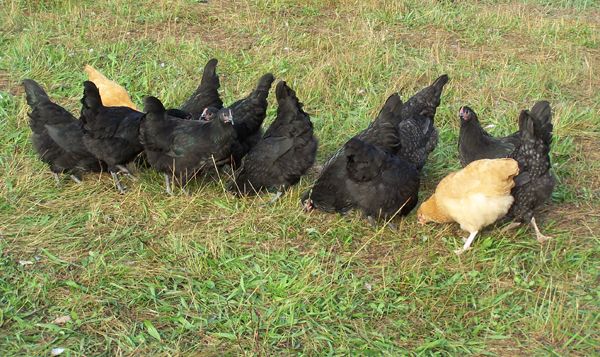
Feeding Birds on Free Range:
• Free range cannot provide a complete diet for modern day birds
• Allowing poultry to free range, even for short periods results in happier birds and less boredom problems, but be hyper-aware of predators
• Free ranging can provide up to 20% of the necessary nutrients for a production bird
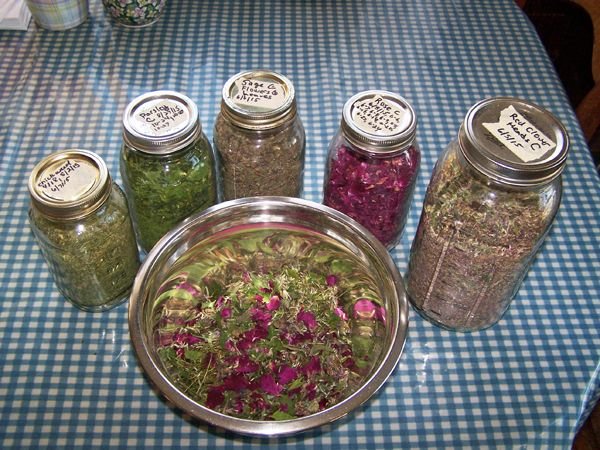
Dehydrated herbs for the layers. I make a custom mix from the 42 different herbs, forbs, and flowers every 4 -5 days.
Supplementation:
• Chickens are omnivores, meaning they eat meat and plant foods
• Chickens feed until there’s a certain weight in their crop, then they stop
• It is best to avoid foods that are empty calories or very wet
• Water is heavy and will cause birds to stop feeding before their nutrient levels have been met
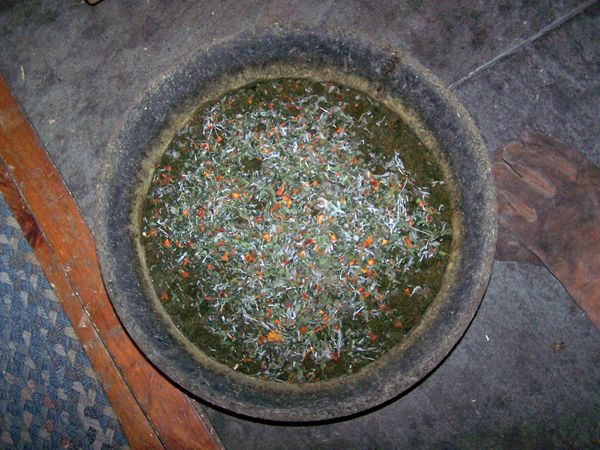
Alfalfa mash with dehydrated herb mix
• You can feed table scraps, garden products, meat, and cheese to reduce costs
• Feeding should be limited to what your birds will eat in 10 to 20 minutes
Root vegs strung on a garland
• Peelings, stale whole grain bread, and leafy vegetables such as cabbage, and cauliflower, turnips
• A protein source is bugs. Chickens will seek these out as they free range. You can also raise mealworms for them
• Milk is a valuable feed but should be fed sparingly. Put it in plastic, glass or enamel containers, as the lactic acid formed will rust galvanized containers
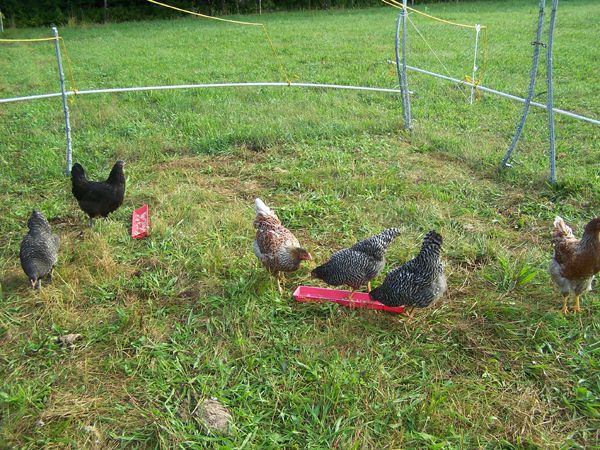
Feeding animal protein to the broiler flock
• Meat or fish at 1/8 - 1/4 ounce per bird per day will result in healthier, and happier, birds; stops or prevents picking, feather eating, and egg eating; meat/fish can be whole or ground, fresh, or cooked; avoid the carp family of fish for poultry as they contain an enzyme called thiaminase that is harmful
Sources of meat/fish:
- Ask for the waste from butchering (cow, pig, deer)
- Ask for unwanted fish from fishermen or hunters
- Roadkill
- Big cheap cans of mackerel from the store
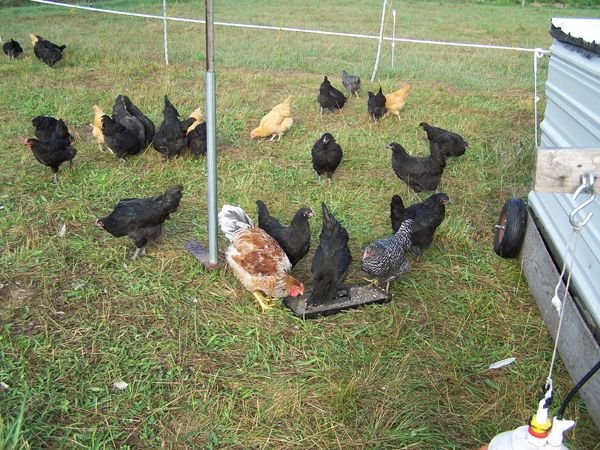
Grit tray for broilers
Grit:
If your birds are fed whole grain or green forage they will need to receive insoluble grit such as granite or other hard mineral and have it available free choice. It is available in chick or hen size. Fine gravel is an acceptable substitute for purchased grit but be very careful where you source it. Road grit will have salt residue and too much will kill birds.
Calcium, bone, or seashells do NOT substitute for grit. Calcium sources dissolve in the birds' system, grit does not. Grit is used as "teeth" to grind up hard grains, etc.
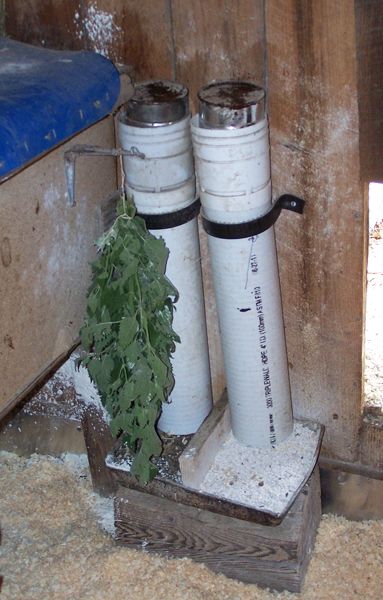
Grit and Calcium feeder
Calcium:
• Laying hens require large amounts of calcium for egg shells
• Growing chickens require only about 1.2 percent calcium in their feed
• Offer free-choice feeding of oyster shell or crushed egg shells
• Wet egg shells should not be fed because of danger of bacterial growth
on the residual albumen
• Higher calcium laying feeds used for growing chickens can result in kidney damage
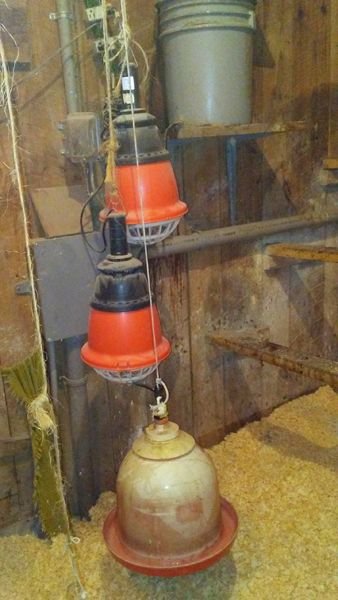
Keeping the waterer open in winter, down to -20F
Water:
• It is the most important nutrient for poultry. The lack of adequate supply will adversely affect the bird's performance more quickly than a shortage of any other nutrient
• It plays a very important role in digestion and metabolism of poultry
• There is a strong correlation between feed and water intake
• Water intake is approximately two times the intake of feed on a weight basis
• It softens feed in the crop to prepare it for grinding in the gizzard
• Birds should have unlimited access to clean water, especially in winter
Feed Management:
• Keep feed as fresh as possible
• Never put moldy or contaminated feed in feeders
• Clean feeders as needed
• Large galvanized garbage can with a tight lid makes an excellent storage container
• Feed loses its nutritional quality when stored too long. It should be used up in two or three weeks
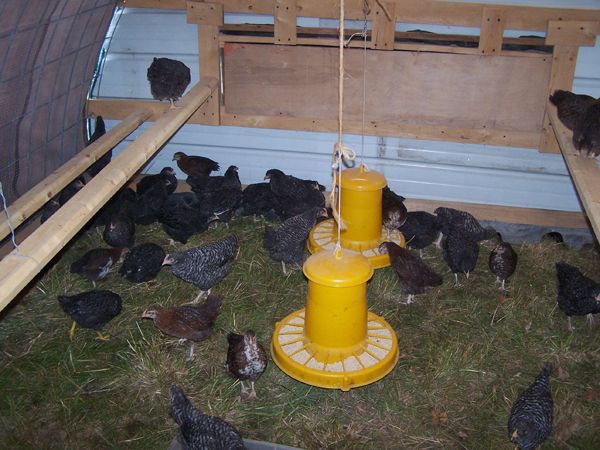
• You need about four inches of feeder space per bird. Plan to have enough so all birds (of any age) can eat at the same time.
• Feeders and waterers should be raised as the birds get older. The top of the feeder side should be raised to at least the level of the bird's back as it stands (in a normal position) on the floor. The birds should have to reach up and over the edge of the feeder. This will help prevent feed wastage.
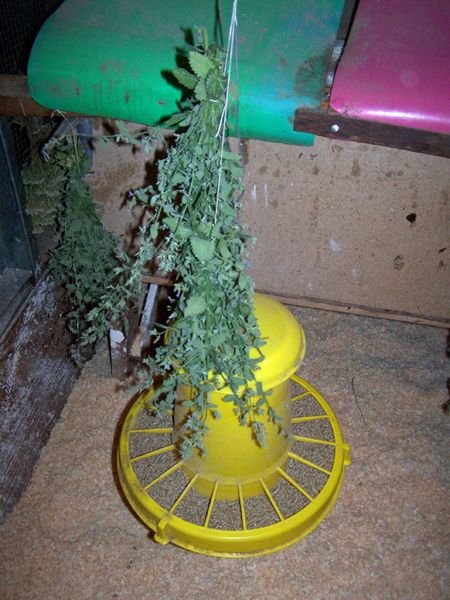
References:
https://carleton.ca/linr/wp-content/uploads/Reading-for-Environment-and-History-Horowitz.pdf
http://anytime-films.com/watch-movies/watch-the-chicken-of-tomorrow-1948-online/
ARKANSAS LAND AND LIFE Vol. 9, No. 1, Spring/Summer 2004: Chicken of Tomorrow 1951.pdf, pgs 14 - 16
Nutrition for the Backyard Flock.pdf. University of Georgia, College of Agricultural and Environmental Sciences, Leaflet 396, Nutrition for the Backyard Flock, Larry Vest and Nick Dale, Extension Poultry Scientists
http://www.professorchicken.com/
http://unionpoint.com/category/ask-alice/
Credit:
Chicken and Mouse - Thejk at German Wikipedia (Original text: Jonas Kemmer)
Chicks with greens - SanduStefan
1910 homestead - Department of the Interior. Bureau of Reclamation.
Thank you for the time you put into helping others learn. If everyone wrote how to articles with as much detail, information and photos as you, we could build a HUGE resources to help people far into the future. I am printing out many of your posts and saving for a SHTF situation when laws regarding limits on what you can do on your own land no longer exist!
Of course, this post has also been added to the Sotall Directory
Thank you for your kind words! I have done the same with others posts, highly informative and lots of photos, so I print them out. For exactly the same reason....
Thank you for adding this to the Directory.
Very detailed, really great information.
Wonderful post, I'm glad @sotall linked it so I found it this morning!
Regarding the calcium needs of laying hens vs growing chickens. What do you recommend in the scenario where we've already got a small established flock of layers and are going to be doubling it this year? Last year we kept the younger chickens in a dog crate in the coop with their own food for as long as possible, but they outgrew the crate before they were full grown so they ate the layer feed along with the older hens. If that's an issue I might have to rethink getting 6 new chicks at once.
I've not tried to raise smaller birds in with larger birds. The bigger birds tend to attack the little ones. I kept them next to and separate from the big ones until they were full grown, which is near laying age. So they were fed non-layer feed.
If you were to put them in together, I'd tend to go with non-layer, make sure there was plenty of oystershell available to the layers, and be very aware of impending behavior problems due to the different feed. You may have to supplement the protein for the layers with animal protein until the younger ones start to lay. Then they can all go on layer. Continuing the animal protein after that point is a good thing to do, as it will prevent behavior problems down the road.
Thanks so much for the response!! I shared this post with the Husband, and because of it, he picked up a couple cans of mackerel at the store! I LOL'd when he showed it to me. We've been having trouble with feather picking, and my internet research had led me to conclude worms were the issue....deworming did seem to solve some other symptoms, but not the picking. This article was a lightbulb moment for me on why anytime I give them assorted kitchen scraps they go like gangbusters after any meat first. They went crazy over the mackerel this afternoon. Fingers crossed they'll grow their fluffy bottom feathers back! I'll definitely be referencing this again as I work to tweak their diet :)
Just make sure you keep it under 1/4 oz/bird/day or you will start with other nutritional problems. They MUST eat ALL their conventional food during the day, and not gorge on meat.
Good to know! I'll go sparingly with it :)